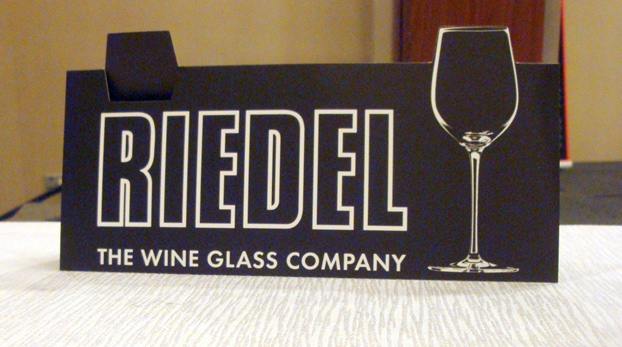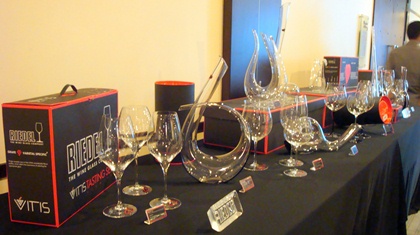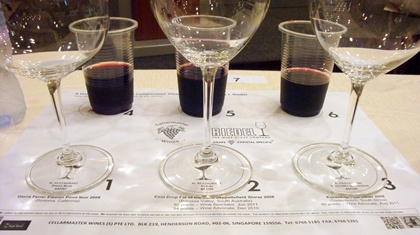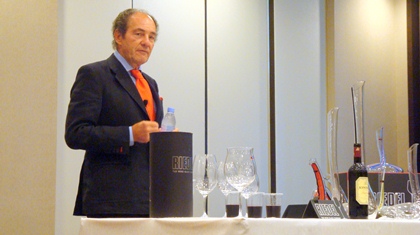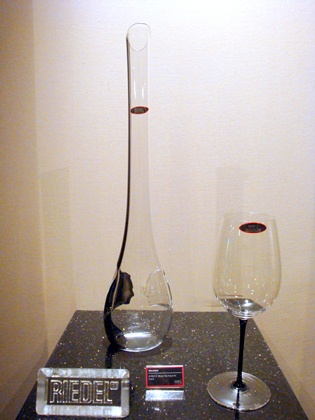5th June 2012, Grand Copthorne Waterfront Hotel – I was one of the first few to arrive. Outside the Riverfront Ballroom was a display of Riedel wine glasses and decanters. The red and black box design and labels gave the glassware a very fashionable and chic feel. A video of Riedel glassware production was on the roll at the middle of the foyer, it showed that the wine glasses were made by hand individually by the glass makers.
The reception area was soon filled with guests from different establishments all related to hospitality - restaurants, bars, hotels and even the airlines. It was a crowd which target were prestigious customers. The host – Cellarmaster Wines (S) Pte Ltd – announced to proceed into the tasting room at 3pm. I was very much looking forward to this session after reading many conflicting reports from different sources about any scientific support that Riedel’s wine glasses make your wine tastes different.
Georg J. Riedel was invited to the room when over 60 attendees have seated themselves in front of 3 massive wine glasses and 3 filled plastic cups of wine. Georg introduced us to the glasses; they were the XL Restaurant range: No.1 Pinot Noir (447/07), No.2 Syrah (447/30) and No.3 Cabernet Sauvignon (447/00); to be paired with wines in the plastic cups No.4 Gloria Ferrer Etesian Pinot Noir 2008, No.5 First Drop Fat of the Land Seppeltsfield Shiraz 2008 and No.6 Kanonkop Paul Sauer 2008.
In this presentation for his guests from the industry, George said that Riedel plays a role as though a piece of mosaic in the hospitality business. Wine is an enjoyment of life and it is his guests in the room, the people from the hospitality business, to convey the message to their customers the best way to enjoy it.
Georg wanted to prove to his guests that a glass has impact in the way the liquid flows. He first asked us to taste the chilled water already prepared using the three glasses. He said the reason for using chilled water was to activate our tactile sensation on our palates, of which it represents the 3 senses - oral burn, temperature and structure. That means we can feel if the liquid is watery, oily or creamy.
He explained that our second automated reflex after breathing is swallowing, which when we drink from a glass or bottle, receives the flow of the liquid on gravity. Using the effect of gravity, we are able to direct the flow of liquid to different parts of our palate. The size, shape and rim diameter have impact on directing the flow of liquid to the different parts of your palate. Here is his run-through:
With Water
Glass No.1 - Most of the water flows to the front tip of your tongue, very little on the side or the back.
Impact - Glass No.1 is with a little lip, it creates a very pointed flow and directs the water to the front of your palate.
Glass No.2 - Water goes all the way to the back of your palate. You can now taste the minerals and the flow accentuates the salty component of the water to your palate.
Impact - This glass has the narrowest rim diameter among the three. The narrower the rim is, the more you need to move your head backwards in order to initiate flow.
Glass No.3 - The water hits the front, then the side and then the end to the back of your palate. Cool surface on all sides of your palate equally.
Impact - The act of swallowing takes a bit longer as the flow of the water displays equally by the shape of the glass.
After this, we proceeded to the second part of our tasting – using the same glasses with wine. Georg said that the emphasis of the liking for the wines will be stronger according to the use of the glasses. He first explained the reason for choosing the wines, which were sponsored by Cellarmaster:
“The reason of the wines selection is because all are French varietals, very popular and are predominantly new world wines. Part of the DNA of the grape varietals defers depending on the thickness of the skin, it extracts colour and is responsible for the tannins. Pinot Noir is produced using grapes with thin delicate skins which gives a light colour and low to medium tannins whereas Cabernet Sauvignon uses grapes with thick skin and it has huge tannins. Who thinks that varietals which carry this kind of difference can be served in the same glass and can give the varietals justice? I would say – impossible.
We have here the extreme position of glass No.1 & wine No.4 and glass No.3 & wine No.6 and the main stream is wine No.5, which means the most versatile glass is glass No.2. You will be shocked and will not believe me. You might want to change your advice what to serve in what glass after leaving this room.”
Here is the tasting according to Georg.
With Wine
First we pour wine No.4 (Pinot Noir) into all the glasses No.1, No.2 and No.3. We were asked to pick up glasses, swirl it and check the aromas for all 3 glasses.
Wine No.4 - Pinot Noir
Glass No.1 – Red fruit with a little smoky character and then concentrate on the secondary aromas which are spices and the green elements. The wine in this glass should taste very fruity with a tiny bit of bitter component.
Glass No.2 – Emphasis more on the secondary aromas. You will also discover the third aroma of the same high level of minerality from the soil.
Glass No.3 – The wine should smell greener and heavier with yeast in this glass and does not feature any fruit of the wine. You can taste a lot of acidity, minerality and a big part of the green component at the back of your palate.
Georg said that the aroma of the wine is released according to the accumulation of molecules. First it is by the molecule size and secondly, by its weight, which gives the layer concept. However, aroma does not matter as it is the taste that plays the important role in the appreciation of wine.
We were instructed to taste the wine from the plastic cup No.5 (Syrah). It was said that it had a nice minerality and gentle tannins.
Wine No.5 - Syrah
We were then told to pour half of it to glass No.3, swirl it and check the aroma. Georg said we should taste lots of yeast but when it comes to the taste, the plastic beaker was a better choice. The audience was in a more relaxed mood after hearing Georg’s disparaging remarks of his own products. He asked us to try the same wine in glass No.2 – now the wine should taste spicy and fruity with a creamy texture and a lot of fruit, sweet and soft with nice peppery notes.
We poured wine No. 6 (Cabernet Sauvignon) into all the three glasses equally. Here are Georg’s tasting notes:
Wine No.6 - Cabernet Sauvignon (as per presentation)
Glass No.3 – Smell sweet, minty, leather, chocolaty and tobacco with diverse and sweet the aroma, every characteristic of this wine.
Glass No.2 – Smaller glass makes the aroma of the wine very concentrated but one dimensional.
Glass No.1 – Wrong choice of glass, as wine fades in this glass and lost its personality. You probably can’t recognise it as Cabernet Sauvignon.
Cabernet Sauvignon with chocolate (Valrhona Guanaja 70% cocoa)
We were asked to taste the chocolate, try to melt in our mouth and cover the whole palate. This is to test if you have food in your mouth, does shape of the glass matter? Here is his analysis:
Glass No. 1 – Georg said that in this glass the wine tasted oaky, this wrong choice of glass gave lesser satisfaction to the taste of cocoa in the palate. The acidity went to one direction and chocolate went to another, there was no marriage.
Glass No. 3 –You should notice that there was a marriage in the combination of wine and chocolate. They are nicely intertwined and come together with the sip of wine.
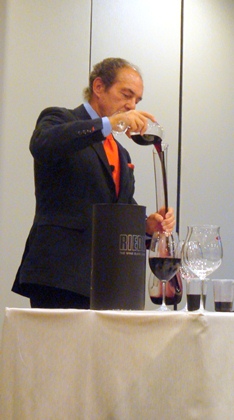
Georg’s Conclusion
“Each varietal has its own glass. Please re-assess the glass you are currently using with the wine list you have.” Georg then introduced Riedel’s iPhone application that helps to decipher the type of wine that matches the type of glass.
The Writer’s View
I attended this event with an open mind, wanting to see by myself what those who disapprove of Riedel’s theory1 saw and experienced during the tasting and compare the presentation to those who support it2.
I am not a wine expert and only base the liking of the wine on how I feel when I drink it. I cannot say that I felt much of a difference in terms of taste for the wines in the experiments above other than the intensity of their aroma using different glasses. However, I do agree with the last notes provided by Georg when combining chocolate and Cabernet Sauvignon using glass No.1 and No.3. I did feel that when drinking from glass No.1 after eating the chocolate, the acidity of the wine was distinctive from the sweetness of the chocolate; whereas when drinking from glass No.3 after eating the chocolate, the two blended together and created a more intense taste on the chocolate that caused me to sneeze (I usually sneeze when eating chocolate with high content of cocoa, in which the chocolate given to us during the tasting consisted of 70% cocoa was almost sufficient to cause the sneezing.)
Whatever others say is, in my opinion, hearsay. I would suggest experiencing it yourself so that you can get a more accurate conclusion. Buy the glass or visit an outlet which uses Riedel glasses. If the glasses do change the enjoyment of your wine, especially when you are drinking it with good company, the crystal glasses should be worth your collection.
If you have any queries about the products, please refer to the Riedel page here.
1. Shattered Myths by Daniel Zwerdling in Gourmet Magazine, published August 2004.
2. “The finest glasses for both technical and hedonistic purposes are those made by Riedel. The effect of these glasses on fine wine is profound. I cannot emphasize enough what a difference they make.” - Robert Parker in The Wine Advocate (which publication date unknown).
